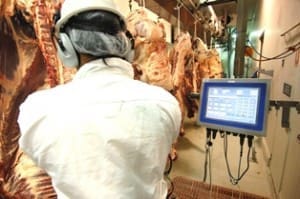PRE-CHRISTMAS predictions of a sub-US70c Australian dollar are now a distant memory, as the currency sails along merrily this morning at US77.7c – it’s highest point since May last year.
The 12 percent appreciation in the dollar over the past three months has knocked the stuffing out of Australian beef’s competitiveness on the international stage. Equally concerning is that the currency appears to have found a level at around US76-77c, and is proving hard to shift.
 Currency considerations, together with previously reported lacklustre trading demand in key markets, continue to drive the market sentiment for slaughter cattle – and especially so in higher-value segments like grainfed and EU.
Currency considerations, together with previously reported lacklustre trading demand in key markets, continue to drive the market sentiment for slaughter cattle – and especially so in higher-value segments like grainfed and EU.
The dollar’s performance leaves margin-squeezed processors with two options: try and get meat prices higher to provide some cover, or cattle prices lower.
As illustrated in last week’s NLRS Eastern States kill report, slaughter numbers are starting to rise as dry conditions encroach over more country, and cooler nights remind producers in susceptible areas that frosts are on the horizon.
The seven-day cycle ended Friday saw a five-state slaughter tally of 145,509 head – the second highest weekly kill recorded so far this year – but still a mile away from the same period last year when numbers came within sight of 180,000 head.
Tallies in states like Queensland and NSW are only likely to grow further in coming weeks, especially after the ANZAC long weekend is cleared.
Two recent absences from Queensland processing ranks are now both back to work. JBS Townsville re-established its kill as planned on March 30, adding an additional 660 a day to the state’s weekly kill this month. Further south, Kilcoy Pastoral Co returned to work this week after its routine three-week maintenance break, adding another 850-a-day to state throughput.
On top of that, Beef Central gets a general impression that other Queensland processors are now a little better covered for forward kills than they were only three or four weeks ago. Most sheds are now killing normal five-day weeks, albeit some with reduced manning per shift in line with cattle numbers. A number told us they were now reasonably well-subscribed for slaughter cattle until the week starting May 9.
Little change in grids
Queensland grids this week were more or less unchanged, with four-tooth grassfed heavy steer at 490-495c/kg, and 440-445c for heavy cows. Grainfed processors are currently feeling considerable pain, processing feeders bought earlier at 360c/kg liveweight, with some reports suggesting sub-500c/kg carcase weights in forward pricing on August delivery forward price cattle.
Earlier expectations for April rain now appear dashed, and it’s stimulating producers in some grazing areas of Queensland and NSW to start to sell early. This, coupled with the fact that there appears to have been only very modest plantings of winter oats so far this year (more on that later) suggests further slaughter supply constraints could apply into the back half of the year.
Western and Channel Country cattle will also be in short supply this year, evidence suggests, from the traditional turnoff period starting around mid-year.
Queensland’s kill last week reached 70,687 head – the highest tally so far this year – up 4pc on the previous week but still down 19pc on last year.
NSW accounted for 35,619 head last week, up 3pc on the previous week, but down 20pc year-on-year.
Victoria rose 2pc to 27,092 head (-17pc on 2015), while South Australia was unchanged at 7457 head. Tasmania’s kill rose 7pc to 4654 head.



HAVE YOUR SAY